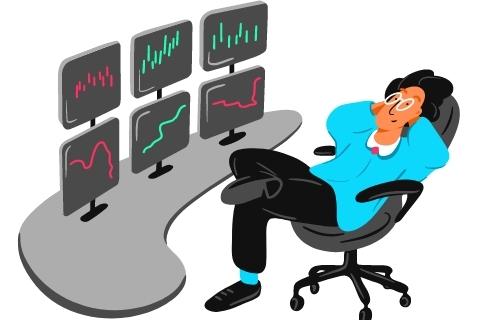New traders taking to the spread betting markets for the first time are required to think about their spread betting strategy, and decide on how best to approach the markets with a view to maximising returns. One method that raises its head consistently in some trading circles is day trading, where traders take short term exposure to markets and trade positions over the course of no more than one trading day. This has a number of apparent advantages over trading over longer periods, and traders tend to favour it is a lower risk way of generating a yield. But is day trading in fact as low risk as it seems to be, and what factors should traders consider in weighing up whether to trade long or short term?
Key Point: Is Spread Betting the Same as Day Trading?
Spread betting is not the same as day trading. Day trading is a trading style where traders open ultra short-term positions and close all of them by the end of the day. On the other hand, spread betting is a financial derivative offering traders a tax-free and leveraged access to a wide range of markets.
Why Day Trading Appeals
Day trading appeals because it sounds initially as if it solves a problem. The theory runs that by trading more frequent, smaller positions, traders can hit more numerate successes with smaller profits but also a much smaller risk profile, delivered mainly through the reduction in market risk as a direct result of capping the trading timeframe. Traders often feel as though day trading is less hard work because the opportunities they need to find to succeed aren’t as intense – with many small positions easing the burden on ‘home-run’ trades.
For all these advantages, traders need to weigh up the corresponding negatives to decide whether day trading is truly for them. For the most part, traders tend to graduate away from shorter-term trades as they develop their expertise, but that’s not to suggest that day trading strategies can’t be made to work.

For these reasons, day trading is generally (and perhaps erroneously) considered to be ‘easier’ than extending the timeframe of the transaction. But without a full consideration of the downsides, traders will find it difficult to make this assessment.
Day trading is a lot of work. Whereas with long-term strategies you’ll open one position, day trading needs 10. More numerous positions are usually the answer to offsetting the dampened returns (that come with the dampened risks of a short timeframe), this also incurs additional trading costs in the form of leverage. This combines to make day trading more effort, more expensive, and less rewarding on a transaction-by-transaction basis.
While the risks might be comparatively lower transaction by transaction, the odds are stacked against day traders from the off, given the need for consistent, repeatable success in an unpredictable, often volatile trading environment. Before deciding whether or not to day trade a position, it’s worthwhile knowing and understanding how your decision might affect your trading behaviour and outcomes.
Read more: Best Spread Betting Brokers in the UK
Spread Bettors – How Day Traders Make Money
Day spread betting is a common type of spread trading, often naturally assumed to be an easier proposition than longer-term strategies because of the shorter time frame in which opportunities (and risks) are allowed to develop. Trading through the course of the day, sometimes considerably sooner, day spread bettors will look for quick profit opportunities, swings and market corrections in order to maximise their returns in the shortest period of time.
Day spread bet traders will look for opportunities over the ultra short-term. The idea is to find more frequent, less developed opportunities that can be aggregated in a lower risk, less research heavy way to generate a return on capital. This means keeping a close eye on the markets and how they behave in order to be in a position to react to trends and price bursts as they happen for maximum returns. While traders may hold positions overnight, the generate tendency for day traders is to cap trades at around the day mark, before new variables, market conditions and externalities arise and influence the market.
What Are the Most Popular Markets among Day Traders in the UK?
To successfully day trade, spread bettors would be looking at the markets which could provide considerable volume and volatility within a day such as forex, FTSE100 and the Dow, oil and gold. Normally, the potential trades are researched before the trading day starts.
Day trading spread bettors are defined by the timeframe of their trading, and so for the most part day trade bets are more than sufficient. In fact, for many day traders and other ultra-short termists, even a day is too long a timeframe to allow positions to run for the strategy, so traders will find themselves quickly in and out over a short time frame where they fall into this category. Rolling daily bets, which carry over the turn of the trading day in as cost efficient a way as possible, are also used both throughout the trading day and for positions that mature slightly later in the day, to provide traders with a flexible tool for handling the market.

Disadvantages
Trading over shorter market cycles isn’t necessarily all it’s cracked up to be, and there are two clear and major drawbacks to this type of trading outlook. Firstly, traders on the short-term don’t have as much time to absorb risk, but these same restrictions apply on the profit side too. That means traders need to find more frequent successful positions, which technically makes the job harder than that of a trader looking for one or two larger trades. Similarly, greater frequency means the accompanying research burden can soon mount up, with traders constantly on the look out for new markets and new opportunities.
Day Traders: Winners Or Losers?
Day trading is a popular style of financial spread betting where traders look to find positions that can be profitable for them over the day. The logic runs that by trading across a greater number of smaller positions traders can keep the market risk (i.e. the risk of a market collapse while their capital is exposed) at a minimum and rack up smaller but more frequent profits from the many small opportunities available in the markets. As such, it appeals to new traders and those looking to trade their capital on a cautious basis, although many of its early proponents will switch to longer-term strategies as they develop their experience and trading expertise. So how does day trading stack up against longer-term strategies, and are day traders actually losing out as a result?
Why Day Spread Bet
The advantages of day trading are in themselves quite appealing. Market risk is always a concern for traders, not to mention the opportunity cost of locking up their capital in a particular position or market. The ability to trade lightly across more multiple positions means that traders can use their capital more broadly in exploring positions, without the same level of risk or commitment attached to each position. This enables traders to be more free flowing in how they trade and to move their capital around markets at comparatively lower risk to find the most profitable, short term opportunities.
In the same breath, any day trading position that is profitable is a bonus, and because traders will enter multiple different positions, each individual trade needs to move less substantially to make it worthwhile. In other words, day traders can exploit ‘easier’ returns, through the low-hanging fruit of micro-opportunities that might not be as viable for traders with a longer-term outlook.
Dangers of Day Trading
While there are benefits to trading ultra short-term, it’s important nevertheless for traders to realise that it’s not a strategy without serious limitations. Firstly, from a purely practical point of view a greater number of trades to manage and execute can be a headache, particularly when factoring in research time. With day trading as a strategy, more frequent trading is guaranteed, yet still with the rewards from each transaction will be comparatively lower. This skews the effort to reward ratio in a less than favourable direction.
Furthermore, with less time for larger price swings to set in, the potential rewards are suppressed by day trading strategies. And when there are fewer points going round, the marginal cost of the spread (which accounts for the broker’s commission) becomes a much more serious consideration. The more transactions with thinner returns you’re trading, the more heavily felt the spread is going to seem as a trading cost, and in fact it is usually for this reason that traders ultimately switch away from day trading strategies.
To say day traders are either winners or losers would be too simplistic, but it’s important to recognise that the strategy has both benefits and unique drawbacks. For this reason, it’s up to the individual trader to make an informed decision about how best to manage his capital, in full recognition of the risks and opportunities posed.

